

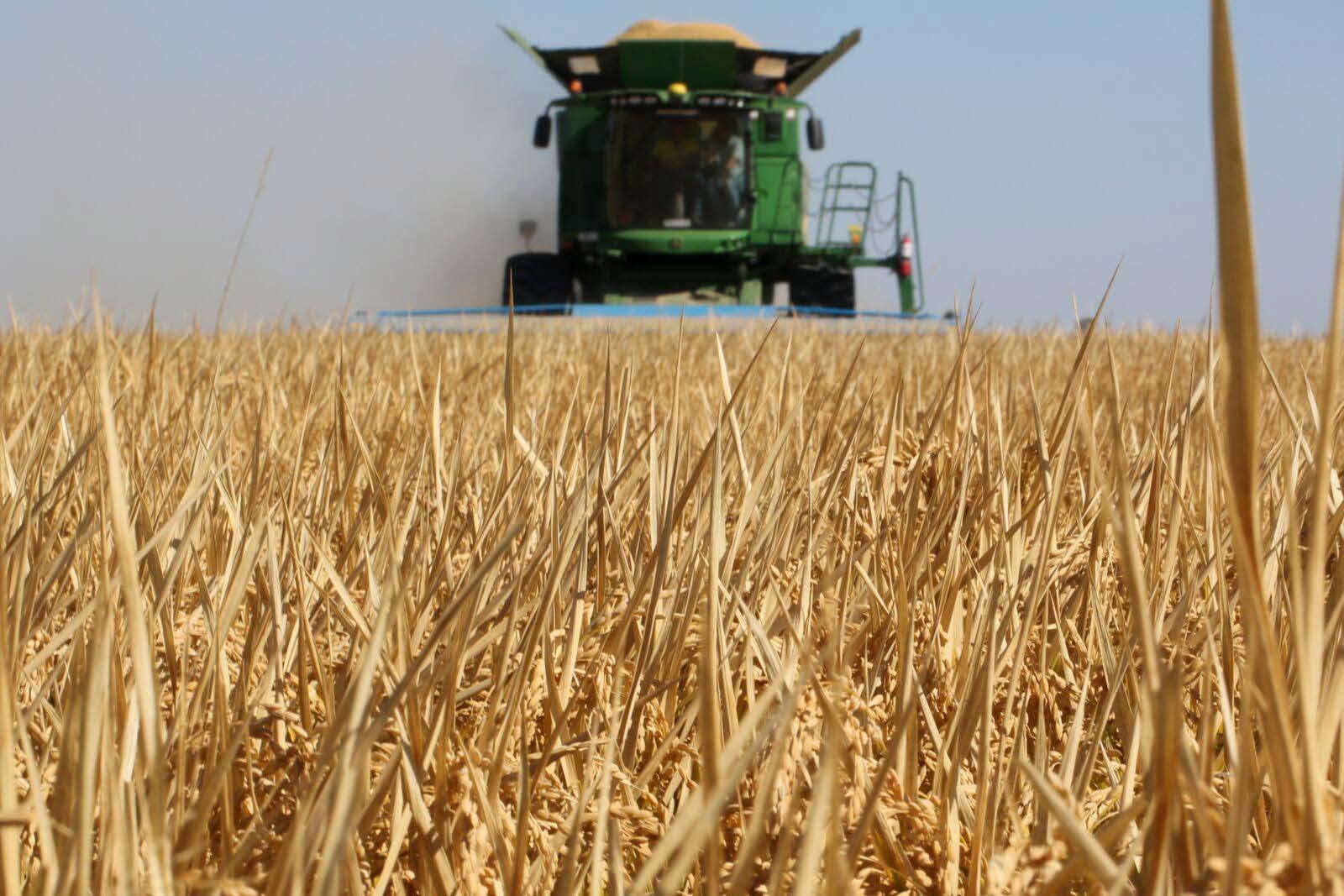






Welcome to the first edition of the Rice Extension Annual Summary.
This summary aims to take a snapshot in time of the season that was, capturing key research, development and extension activities.
AgriFutures Australia fund the Rice Extension project with in-kind support from the SunRice Group and Rice Research Australia. The program has a clear vision to ensure Australian rice growers are global leaders in sustainable rice-based farming systems. This will be achieved through knowledge sharing, innovative thinking and a collaborative science-based approach.
The AgriFutures Rice Program is responsible for managing and investing the rice levy in research, development and extension (RD&E) projects. The RD&E investment is guided by the AgriFutures Rice Program RD&E Plan (2021-2026). Developed in consultation with industry, the Plan identifies and balances the RD&E priorities and outcomes to promote industry productivity, profitability and sustainability. The Plan is based on an overarching Program goal of increasing the Australian rice industry’s water productivity to an average of 1.5 t/ML by 2026 and investment in targeted and high-impact projects will help achieve this goal. Rice Extension is one of 14 current projects underway in the Program, with more projects to commence soon.
It’s our job to:



Communicate research and development findings, farming systems, grower innovations, and natural resource management information to growers and industry stakeholders through print, electronic communication, verbal and face-to-face interactions.
Facilitate workshops, field days, farm walks, meetings and discussion groups at key times for growers, advisors, researchers, and industry stakeholders to share information.
Support the rice industry by promoting our industry’s credentials, developing and maintaining technical expertise and drive new research and practice change through data-driven decisions.
In CY23, the Rice Extension team focused on the basics during the unprecedented flooding and looked to be adaptive to grower and advisor requirements. We took the time to listen to your feedback and understand how and where we can add value to levy payers’ businesses. In CY24 we are looking to implement an innovative and ambitious initiative through the Best Management Practice (BMP) Sites across the Riverina. These sites will be the focal point for collaboration and knowledge sharing to continue driving practice change across the industry, as we strive for the ambitious 1.5t/ML water productivity target.
I hope the Rice Extension Annual Summary will provide relevant and purposeful information to accurately capture the CY23 rice season and the hard work being done by the many organisations, researchers, industry staff, advisors and growers to make our industry what it is today.
The Rice Extension team would like to thank everyone who shared their detailed crop data, extensive knowledge, and time. The better data we have, the more relevant information we can get back to you to enhance a profitable and sustainable rice-based farming system.
Thank you.
Kind Regards,
Peter McDonnell
PLEASE NOTE, ALL INFORMATION AND DATA IN THIS SUMMARY IS A REPRESENTATION OF WHAT WE HAVE OBSERVED THROUGHOUT THE CY23 SEASON. IT IS NOT A REPRESENTATION OF OUR VIEWS OR OPINIONS AND DOES NOT ALWAYS ALIGN WITH BEST MANAGEMENT PRACTICE AND RECOMMENDATIONS.


Peter is based at Rice Research Australia Pty Ltd (RRAPL) in the Eastern Murray Valley (EMV). Peter began his career in agriculture as a productivity officer managing seed cane distribution, and pest and disease monitoring in the Burdekin sugar industry. In 2006, he started his own consulting company focusing on precision agriculture and decision support tools. In 2010, with several like-minded consultants, he formed Farmacist Pty Ltd, which continues to deliver agronomy solutions to farmers across industries. In 2016, Peter joined the SunRice Group as Grower Services Manager in North Queensland, and in 2019, he assumed operational responsibility for the SunRice mill located at Brandon, North Queensland. Peter recently took up the position of Rice Extension and Innovations Manager based in the Riverina, with a passion for advancing the Australian rice industry through collaboration and innovation.
Mark works from the Murrumbidgee Irrigation Area (MIA), and has been involved in the irrigation and rice industry for over 20 years. From an agronomic background, he has worked with many irrigated crops and water efficiency projects throughout eastern Australia at the farm and valley level. Mark began with the SunRice Group’s Grower Services team in 2016, collaborating with growers, researchers and industry to enhance the rice-based farming system in the Riverina. In 2017, he gained a Nuffield Scholarship to study farming systems and water use efficiency practices in temperate rice systems throughout different parts of the world.

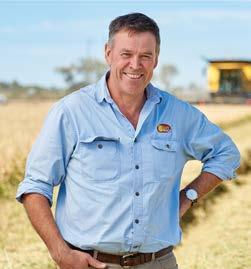

With a background in marketing, communications and agriculture, it makes sense that Jessica does all things communications for Rice Extension. Originally from a small farm at Coleambally, her family now run a sheep and cattle property in the Southern Highlands. Jessica joined the Rice Extension team in January, and brings a strong passion for the rural sector and sustainability, along with a set of marketing skills driving Rice Extension into a new digital age.
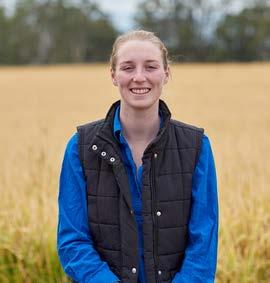
Em is a Jan Cathcart Graduate and Field Extension Officer, working within the Western Murray Valley (WMV). She grew up on a rice farm in Wakool and was awarded the Jan Cathcart Memorial Scholarship in 2019. Emily completed her Bachelor of Agriculture with The University of Melbourne at the end of 2021 and started working for the SunRice Group in June 2022 as a Jan Cathcart Graduate. She completed her first rotatation of the graduate program with Rice Extension and is now working with the Sustainability team.
Anna is a Field Extension Officer for Rice Extension based in the Murray Valley. Anna has a Bachelor of Agricultural Science and over 16 years’ experience in the agriculture sector working for multinational companies, ASX listed and private organisations. Anna began her journey in the rice industry nine years ago at RRAPL and the SunRice Group’s Grower Services team, and has loved seeing the industry innovate to drive farm productivity.
Her passion for agriculture extends beyond her professional experience, Anna, along with her husband and his parents run a farming operation at Finley and Mingay in Western Victoria. She loves nothing more than spending time with her young children, helping with harvest, sowing, irrigating, sheep work and everything in between.


For the last nine years Troy has worked with Rice Extension as a Field Extension Officer in the Murray Valley. He has over 15 years of extension and project management experience and a Masters in Agriculture. When he isn’t working for the SunRice Group, Troy and his wife operate a mixed irrigated farm at Jerilderie.


Burraboi rice growers, Brooke and Neville Hollins took out the prestigious SunRice Grower of the Year Award for CY22, showcasing Woorak Ag and the hard work of four generations of rice growers in the Hollins family.
Several key points set the Hollins’ apart encapsulated but the judges comment that, “Woorak Ag is a tidy operation; as their business has grown, they have adapted their business model to suit. They have taken a proactive approach to planning and adapting new technologies and efficiencies, centered around sustainable cropping rotations to ensure future viability for the next generation”. Brooke and Neville expressed their appreciation for being awarded the title as an honour, “We are truly thrilled to receive it. We do what we do because we love it. We love the highs, the lows, and everything in between. We can’t imagine doing anything else”.

We caught up with Brooke and Nev to ask a few questions about the year that followed their win.
WHAT DID WINNING THE SUNRICE GROWER OF THE YEAR AWARD MEAN TO YOU?
Winning the SunRice Grower of the Year was such a shock to us. While we always strive to have a successful and long-term sustainable business, you never really know how that is tracking compared to other businesses. It is nice to be recognised for the farming practices we implement at Woorak Ag and the business that we have built around that.
We tend to just get on with the job, so it has been a great opportunity to stop and reflect on our operation, and feedback from the judges has been valuable.
“ “
HOW HAS WOORAK AG’S JOURNEY LOOKED OVER THE PAST YEAR?
Since winning SunRice Grower of the Year, life in general has been very hectic! In the days following last year’s awards night, it was a whirlwind full of excitement and opportunities. We have tried to do what we could to promote rice growing, particularly in our area, with the media opportunities that came our way. We are certainly not media superstars and it was very unfamiliar ground for us but we got through it.

Rice planting season certainly threw us (as it does every other rice grower) some curve balls but I think it showed how resilient farmers can be. It was a good year to have the attitude of ‘well let’s give it a go and hope it works!’
MOVING TOWARDS THE FUTURE, WHAT DOES SUSTAINABILITY LOOK LIKE FOR WOORAK AG?
We will keep working on continually having good practices while implementing innovation and technology to ensure that our business remains sustainable into the future.
WHAT WOULD YOU SAY TO OTHER RICE GROWERS WHO ARE WANTING TO MAKE SUSTAINABLE CHANGES WITHIN THEIR OPERATIONS?
Use all of the resources available to make the change. Look at where you are and where you want to be in the future and put a plan in place. Even incremental change will help to improve your sustainability in the long run.
ANY OTHER COMMENTS?
Thank you to Rice Extension and the SunRice Group for giving us the opportunity to be involved with the Grower of the Year program. While no one farms for awards, it has been an experience we will never forget. We have really enjoyed meeting new people and in particular we have enjoyed visiting other farms for the judging of this year’s SunRice Grower of the Year Award.


SUNRICE GROWER OF THE YEAR PROUDLY SPONSORED BY THE SUNRICE GROUP
The yield potential of rice crops is strongly correlated with environmental and seasonal conditions, so before analysing the CY23 season, it is important to give context to the CY23 conditions.
Paddock preparation and sowing were delayed by unprecedented spring rainfall in all valleys, which led to flooding and waterlogged paddocks. Figure 1 shows the cumulative rainfall for Jerilderie during the dominant sowing window. Significant rainfall events are shown in red, heavily impacting field operations for the CY23 season.
It would be fair to say water availability was not the limiting factor in CY23!


The flooding and waterlogged paddocks presented many challenges in getting the rice sown on time, forcing growers to be flexible and adapt to conditions. Adaptive practices included sowing rice without fertiliser up front, changing sowing methods, and even pursuing self-sown and ratoon crops.
Compounding the difficult start, the spring temperatures were below average, with the Cumulative Degree Days below the five-year average (Figure 2) and even lower than the last cold year of CY21 (Figure 3). Degree Days are accumulated whenever the temperature exceeds 10 degrees Celsius and is used to calculate the developmental stages of rice, beginning from the date of sowing. The optimal temperature for rice production is between 25–35°C, and temperature below or higher than this negatively affects the crop’s growth, physiology, and yield potential.
Low temperatures delay rice germination, seedling establishment and hampers tiller formation. Low temperatures at critical crop stages can also impact flowering, cause panicle sterility, and ultimately lead to lower grain yield. Low minimums impacted the season during the microspore period in all areas.
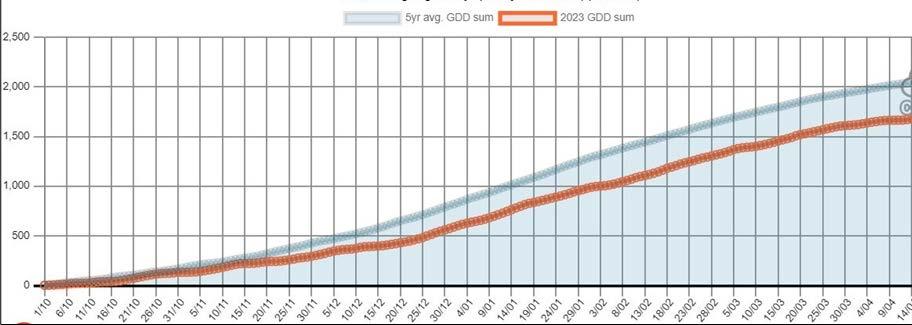
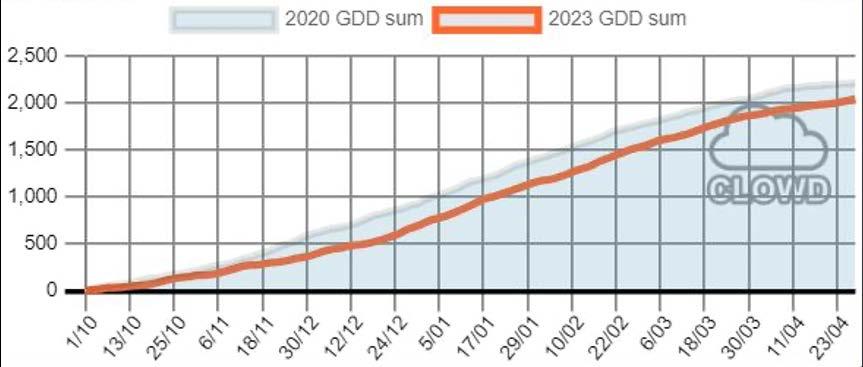

Figure 2 - CLOWDCumulative Growing Degree Days for CY23 vs 5 yr. average
Figure 3 - Cumulative Growing Degree Days for the season vs CY21 (last cold year)

Figure 4 -Temperature comparisons
The percentage area planted to rice in each region was typical of an average year, with the most significant change being the area planted to V071. Following the success of V071 over the past two years on a restricted basis, growers fully embraced the variety, contributing to the total volume grown in such a challenging year. Sherpa increased in volume compared to the last five years.
Due to the late start and cool conditions, the CY23 yields were 12% lower than the five-year average (2018-2022), as seen in Table 1. V071 was the stand-out variety, out-yielding all varieties over a wide sowing window averaging 1t/ha more than the traditional benchmark variety - Reiziq. However, the V071 average was 1.32t/ha lower than the past two seasons. Note that V071 has limited commercial data only from the past two seasons. The MIA region regained the highest average yield at 10.23t/ha, followed by the EMV, WMV and Coleambally Irrigation Area (CIA).




The challenging start to the season meant most crops, particularly in the MIA and CIA, were planted outside their ideal planting window. Table 2 below shows the ideal planting windows by variety for the MIA and CIA.
Table 2 - DPI NSW - Recommended sowing/first flush dates for rice varieties, regions and sowing methods

As shown in Table 3 below, the MIA and CIA were affected the most, with the WMV at the opposite end of the spectrum having achieved the majority of the crop in the ideal planting window. The wet conditions saw a significant shift to aerial sowing or dry broadcasting, particularly in the MIA and EMV shown in Table 4.




This section breaks the CY23 data down into regional areas. It should be noted that the data collection method didn’t allow RE to separate aerial sown crops and dry broadcast (DB) crops, therefore a reference to aerial/dry broadcast (ADB) is included.
Data includes:
• Averages x 5-year Averages x Variety
• Top 20% Yields x Variety for CY23
• Area x Sowing Method
• Yield x ADB x Sowing Date x Variety
• Yield x Drill Sown x Sowing Date x Variety
• Yield x Sowing Week x Sowing Method
• Sherpa Compared to V071 Yields x Late Sowing


All varieties sown in the MIA were lower than the 5-year average yield. Langi was less impacted, but only a few data points were present.
Even though the season had a problematic start, farm-variety yields reached an impressive 14.56t/ha (by farm). In most cases, the top 20% of crops yielded over 2t/ha more than the average, showing the potential of each variety in each region.




the sowing window


Figure 12 shows the advantages of changing sowing methods from drill sown to ADB as sowing dates get further outside the sowing window (Table 2). The results also reaffirm that the later you sow, the average yield declines.

Figure 13 - Sowing x Week vs Yield
Before CY23, the performance of V071 as a late-sown crop was unproven in a commercial setting. Due to the unusual market demand and the unprecedented seasonal conditions, Sherpa’s proven track record as a late sown crop saw the variety released to MIA growers for CY23.

The data in Figure 13 (noting only one year’s data) shows V071 out-yielded Sherpa in all weeks except for the end-of-November sowings. The trend was the same regardless of the sowing methods.
CIA

14 - CY23 CIA Yield x Variety x 5-year average
Late sowings greatly impacted CIA yields with only 8% sown in the window. V071 was the stand-out variety with a CY23 average of 9.6t/ha over a large area. However, it was 2.3t/ha lower than CY22. The Sherpa area was insignificant.
CIA TOP 20% YIELDS FOR CY23
Despite the challenging start to the season, the majority of the top 20% of crops yielded over 2t/ha more than average, with farm-variety yields reaching 12.56t/ha in the region.



Like CY22, sowing within or before the preferred sowing window in CY23 achieved the highest yield.
Figure 17 shows the importance of sowing within the preferred window regardless of the variety to maximise yield. There is a strong correlation (above 90%) between the sowing date and yield.



18 - CIA Yield MG x sowing date
Figure 18 compares the performance of a later sowing option between two medium grains - V071 and Viand. The data suggest that V071 performed better as a late-sown crop but both varieties reduce yield as the sowing window moves later.
EMV


Figure 19 - EMV Yield Averages
The EMV wasn’t immune to the lower yields of other regions. V071 was the highest-yielding variety at 10.43t/ha, 1.21t/ha higher than Sherpa. The impact of the CY23 climatic conditions was evident in V071, yielding 1.34t/ha on average less than in CY22.
Regardless of the difficult conditions, farm-variety yields in the EMV reached 14.26t/ha. This indicated high potential for the varieties, given that the top 20% of crops yielded over 2t/ha more than average in most instances.


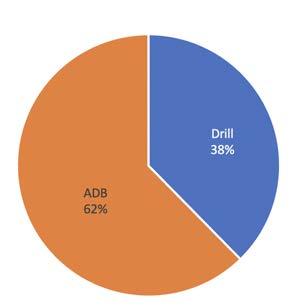
Sowing on time resulted in higher yields in aerial and dry broadcast crops in the EMV. The anomaly is with Reiziq, where only one crop sown in the window was self-sown and hit with hail.


In drill sown crops, sowing on time resulted in higher yields.

23 - EMV Yield x Variety x Window
Figure 23 suggests that yields begin to decline as sowing moves out of the preferred window.
This graph also shows that if growers must sow late, higher yields are achieved by switching to aerial/ dry broadcast sowing.


24 - EMV Yield x Sowing Week
The data in Figure 24 suggests that V071 has out-yielded Sherpa, even in a cold year like CY23. As the time of sowing got later into the year, yields declined.

Like all regions, V071 was the highest-yielding variety, but the surprise was Reiziq out-yielding Sherpa in the context of being a cold year. Viand averaging the same as the 5-year average wasn’t a trend seen in other regions. However, Viand still yielded 1.25t/ha lower than Sherpa and significantly 3.09t/ha lower than V071.
WMV TOP 20% ANALYSIS
Even though the season had a problematic start, farm-variety yields reached 14.19t/ha in the WMV. In most cases, the top 20% of crops yielded over 2t/ha more than the average, showing the potential of each variety in each region.




Aerial/DB crops in the WMV have bucked the trend of other regions in that late sown V071 out-yielded those crops sown within the sowing window. As is the case for Sherpa and Opus, every other region had a yield benefit by sowing before or during the sowing window. Reasons for this include extended periods of deep, dirty (muddy) flood water over some of these crops. The extended flooding caused plant losses and thin spindly plants.


In drill sown crops, sowing before or in the window resulted in higher yields, except for Sherpa, where sowing before the window resulted in lower yields.

Sowing methods are not the limiting factor to high yields, as seen in Figure 29. Drill sown crops had the highest yield overall in this data set. As the sowing window closes (third week of November onwards), aerial/DB resulted in more consistent yields in CY23.

Regardless of the sowing method and timing, V071 consistently out-yielded Sherpa.

NITROGEN USE EFFICIENCY
Data collected from the MapRice GIS and by Rice Extension officers were analysed for nitrogen use efficiency (NUE). While nitrogen is not usually a significant driver of profitability, it did impact the bottom line in CY23 as urea prices were circa $1400/t, as were MAP and DAP. Nitrogen use efficiency is also an important measure of sustainability and may provide additional opportunities in new and emerging markets.
This information is paddock based and consists of a smaller data set than the yield and regional analyses due to fewer people inputting their management practices into MapRice. However, it is still a significant data set capturing approximately 26% of the area sown in CY23. The data also represented the areas sown in each region, as seen in (Table 9).
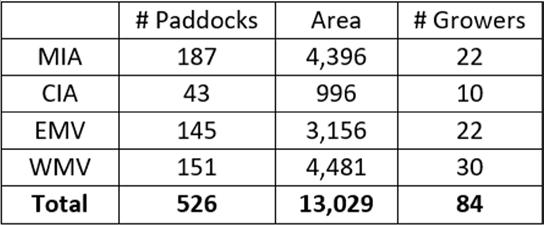


Three varieties had a significant data set for analysis, which included V071, Sherpa, and Viand.

KILOGRAMS OF NITROGEN USE PER TONNE OF GRAIN PRODUCED (KGN/T)
Table 11 indicates the effectiveness and efficiency of nitrogen (N) application. In the 2021 and 2022 seasons, it was 17kg N/t, grain produced; this season, over 19kg N/t, a reflection of lower yields. Adequate N is required for high yields; however, too high can create lodging issues and increased cold susceptibility, often with lower yields, difficult harvest and greater input costs.
If NUE is significantly higher than the assumed benchmark of 17kg N/t, then this indicates inefficient application methods (high N losses) or lower potential yield due to another factor other than N. If NUE is lower than 17kg N/t, this may indicate available organic N in your soil and a measure of soil organic fertility such as a legume rotation or high organic carbon content.





To compare industry and regional average use the table below and follow the formula for fertiliser to nitrogen conversions:
N RATE (KG N/HA) = FERTILISER RATE (KG/HA) * FERTILISER N % (VALUE IN TABLE) NUE = N RATE / YIELD


The summary of the CY23 season data and case studies highlighted the following points:
• CY23 was one of the coldest and wettest on record.
• Sowing crops on time resulted in higher yields.
• Expectations need to be limited if planting later and a conservative approach required with nitrogen application.
• Changing sowing methods (drill sowing to ADB) as the season progressed resulted in higher yields.
• V071 out-yielded all varieties even when sown outside its sowing window and in a cold year.
• Planning and flexibility were vital to achieving high yields.
• Sherpa had higher yields in the EMV than other regions. However, this correlated with higher total N applied.







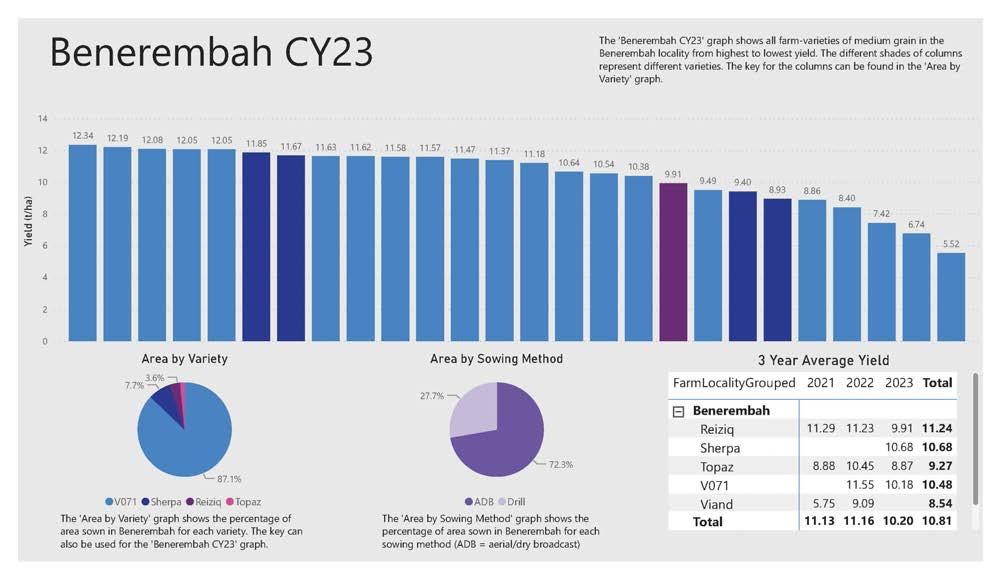





















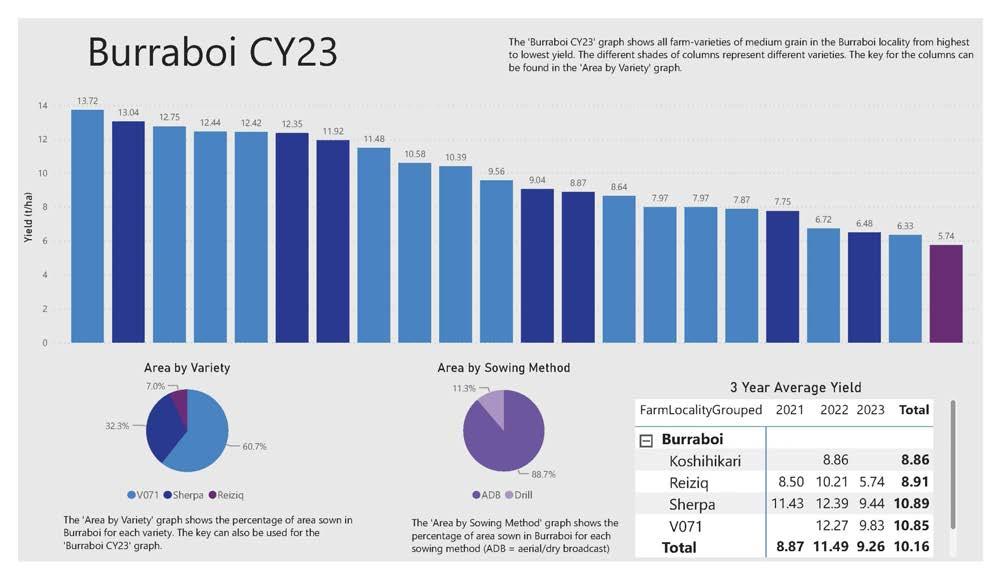










GROWER
CATCHMENT
FLEXIBILITY IN SOWING METHODS AND NITROGEN APPLICATON IS KEY TO SOWING ON TIME IN A WET SPRING TO ACHEIVE HIGH YIELDS.
KEY LEARNINGS
• High yields can still be achieved by applying nitrogen at early tillering through a mid-season drain.
• Excellent NUE efficiency can be achieved by applying nitrogren at mid-season dry down.
• Calibrate spreader before applying urea.
• Address paddock variability prior to permanent water.
OBJECTIVES

John Fowler had initially planned to drill sow his rice in CY23 but due to the continual rain that filled his bays he decided to put in his boards and aerial sow instead. The next challenge was to get the nitrogen requirements on the crop in an efficient and cost-effective way. Having undertaken mid-season dry downs many times in the past to mitigate straight head in Opus, John felt comfortable draining his rice crops and achieving 3cm of dry soil (to maximise nitrogen efficiency) before spreading urea and then filling the paddocks back up again.
John said, “The ideal thing would have been to drill the urea into the soil before filling up to aerially sow. However, as I missed that opportunity, the next best thing was to dry down the crop as soon as it was established enough to survive, apply the urea by ground rig and then fill up again. I considered the fact the cost of the plane was high (compared to a ground rig) and the losses of flying urea into permanent water during tillering were also high.”
“The right time to do it (drain) was a guess this year. We know from delayed permanent water (DPW) practices, the latest you’d want to get the urea on by. But I needed to make sure the rice was mature enough to handle the stress of the draining. But they handled it quite well.”
John did drain a bit earlier than when normally doing a mid-season drain to accommodate getting urea on and the water back on.
The beginning of the CY23 was extremely wet and made for a challenging sowing period for growers. Deniliquin recorded 187mm rain in the month of October versus the long-term average of 39mm (Bureau of Meteorology). Rice growers wanting to drill urea into their paddocks prior to filling up and aerial sowing had limited options. The paddocks were sown on 21 October which is in the sowing window for V071.
John had three paddocks, Pump, Brolga and Wedgetail, totalling 62.5ha. The mid-season drain commenced on Pump and Brolga on 26 November (at early tillering stage) and Wedgetail was drained on 3 December.
Brolga paddock took 11 days to drain to achieve dry soil, Pump took seven days and Wedgetail took 16 days (4mm rain occurred after 9 days) to drain. John was concerned about the growth stage of the plants in Pump and did not achieve 3cm of dry soil so as not to stress the plants. Brolga dried out a lot more than Pump, and Wedgetail had struggled with establishment and weed pressure so also took longer.
Table 1 - Each paddock varied on non-ponded days from 9 to 18 days due to plant growth stage, rain, and weeds.
Permanent water and nitrogen were applied to Pump on 5 December, Brolga on 9 December and Wedgetail on 21 December. They were primarily fresh rice paddocks with mostly winter cropping history. It was on this basis that 300kg/ha of urea was applied to two paddocks (Pump and Brolga) and 380kg/ ha to Wedgetail.
Pump and Brolga were tissue tested at Panicle Initiation (PI) on 13 and 12 January, respectively. Pump had an N uptake of 78 and Brolga was 103N uptake. Pump was top-dressed with between 100 and 170kg urea/ha according to paddock history and Brolga had a blanket top-dress on 100kg/ha. John puts the low N uptakes down to misjudging the fertility of the paddocks, considering their extended periods between rice crops and the pasture history.
Wedgetail PI’d on 17 January and was not top-dressed due to some extremely hot spots in the paddock. John said, “In hindsight I should have top-dressed but there was a lot of variability, and I was worried about blowing the hotspots up - but it cost me yield. I should have addressed the variability at prepermanent water.”
Wedgetail (the poor performing paddock) also missed its final pre-sowing knockdown spray due to the rain. It had considerably more early weed competition, including wireweed (hogweed), growing in the permanent water.

One of the key issues experienced was the striping caused by the spreader. This increased the in-crop variability and impacted on yield. “The worst issue was the striping from the truck with the spreading of urea,” said John.
Another concern was getting good establishment when aerially sowing into bays that had been set up to drill sow. The soil surface was smooth (un-ridged) and John was concerned about seedling drift in the absence of anchorage sites normally provided by a ridge roller. First, John pre-germinated the seed to minimise the time required for establishment, before submerging the seedling until the rice was at the two leaf stage. This caused most of the wave action to be above the soil surface where the seedlings were developing roots. He then lowered the water level so the third leaf could emerge in shallow water, minimising stress on them. This process “seemed to work well for me,” said John.





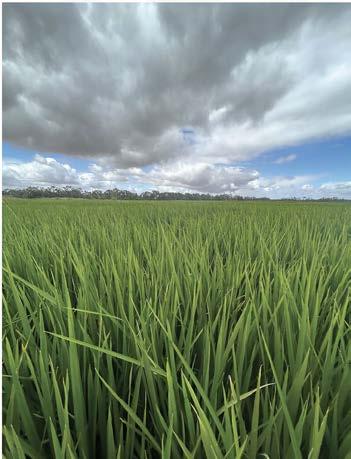
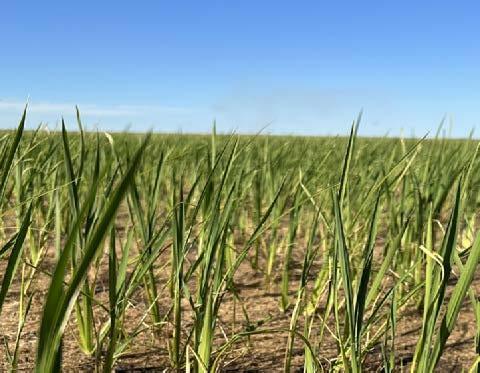




GROWER
CATCHMENT
RICE HA ADVISOR
KEY LEARNINGS
• Employ planning and flexibility in sowing methods to ensure sowing occurs in the sowing window.
• Mid-season dry down to apply starter nitrogen in aerial sown crops was successful but challenging.
• Rice crop growth development can be manipulated through water management.
OBJECTIVE

The Sleigh family wanted to maximise yields by sowing V071 in the sowing window in a wet spring into a rice stubble. The preference was to drill sow with a JD Disc seeder. The rice stubble from CY22 wasn’t burnt until September 2022 and the paddock had some wheel tracks from the wet CY22 rice harvest to add to the challenges.
OVERVIEW
The Sleighs, like everyone else, had the challenge of sowing their rice due to the flooding and continual rain during the CY23 sowing period.The paddock consists of four blocks and had rice stubble and wheel tracks from the CY22 harvest to contend with before sowing.
Once the stubble was burnt it was obvious that working the paddock or drilling urea 7cm plus into the ground wasn’t possible, hence the preference to drill sow (also the normal farmer practice). Sowing commenced on 11 October in which one and three quarters of a block were successfully sown before more rain. More drill sowing was done on 21 October, before more rain.
As the sowing window for V071 was closing, the Sleighs switched to aerial sowing without applying any fertiliser or ground preparation, which isn’t normal practice for them. The bay was filled with water and was rice flown in on 28 October. Establishment was as good as the drill sown blocks - 100 plants m2 compared to 170 plants m2 in the drill sown blocks. Upon inspection of the paddock in late November (and during the mid-season dry down of the aerial sown block to apply some urea) the root system on the aerial sown block was stunted with poor anchorage into the soil on some plants. This could have been a factor of no ground preparation (no tilth) or from snails or both. However, plants were slightly more advanced than the drill sown crops.
The poor root anchorage of the aerial sown crop presented issues during the mid-season dry down as plants with unestablished roots dried out quickly. Although conditions weren’t ideal with water on the ground, track marks, low-lying areas and parts with previous year’s stubble, the Sleighs still applied urea as the risk of losing plants without it was too great. Upon inspection, there was no evidence of urea in the damp paddocks compared to where it was dry and, on the drill, sown where the urea was very evident. These areas (where urea was evident post-spreading) weren’t obvious from then on, either visually or on the yield map.
The Sleighs’ planning and strategy helped achieve their goal. The whole crop reached PI at the same time on 15 January which allowed the crop to be harvested on time, sequentially from 24 April. This was achieved by using different sowing methods and through the strategic water management of the drill sown crops. There were no significant yield differences between the two drill sown crops as shown in the yield map (top right sown 21 October and bottom right sown 11 October), that are of similar soil types. The yields were also similar in the two western blocks (left of the yield map) which compared both drill sowing dates (bottom four bays sown 11 October and top two bays sown 21 October) versus the aerial sown block (top left). The bottom two bays of the aerial sown block suffered severe bird damage, which impacted yield.
Whilst growers can overcome the challenge of getting the crop sown in the sowing window, in many cases this was achieved through aerial sowing without applying upfront nitrogen. Growers in this situation were left with two options.
One, apply a split application directly to the water or do a mid-season dry down to increase nitrogen efficiency. The later was the first preference for many growers but as the season progressed, getting the paddock to dry down, dealing with the drainage water and the time delay in getting the soil dry (due to continual rain events), proved to be impractical in most cases.
However, the Sleighs were successful in doing a mid-season dry down. Analysis from the NIR Tissue test indicated using the mid-season dry down to apply urea was effective. Both the aerial and drill sown crops had an N uptake (100kg/ha and 106kg/ha respectively) from the 350kg/ ha applied around 2 December. This then allowed for a blanket rate of 160kg/ha of urea on 17 January, a few days post PI.
The paddock averaged 10.12t/ha. The importance of sowing on time was evident when compared to the Sleigh’s Sherpa crop that was drill sown in a fresh paddock on 10 November, had PW applied on 16 December, PI’d on 20 January and yielded 8.9t/ha.
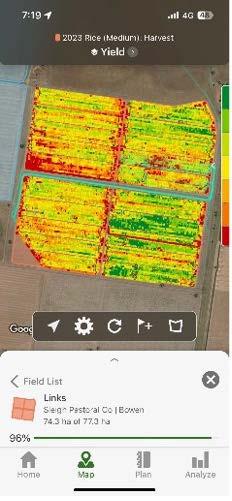
1 (above) - Yield map showing the yield comparison of two drill sowing dates (11/10 and 21/10) and aerial sown block on 28/10. The yield differences were soil related rather than sowing method related.


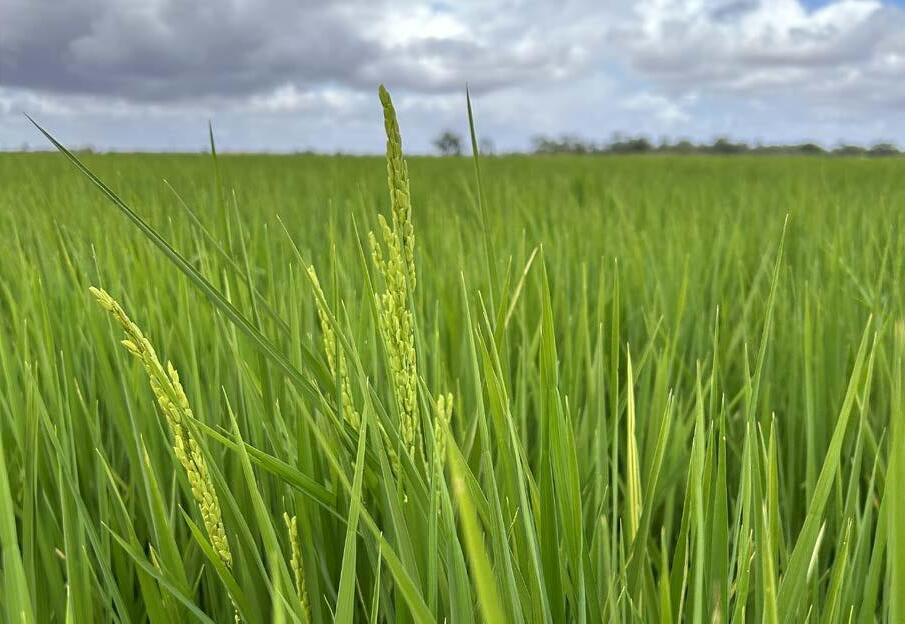
THIS CASE STUDY AIMS TO COMMUNICATE THE FINDINGS OF A SMALL PLOT TRIAL CONDUCTED AT RRAPL IN CY23 IN A VERY WET AND CHALLENGING START TO THE SEASON. THE TRIAL FOCUSED ON LATE-SOWN MEDIUM GRAIN VARIETIES WITH VARYING RATES OF NITROGEN AND THE IMPACT ON YIELD.
KEY LEARNINGS
• V071 has produced more grain than Sherpa or Viand.
• Excessive nitrogen is not required to obtain an average crop, but inputs should remain close to the standard crop requirement.

• Very late-sown crops can perform and make a good return on investment with minimum inputs, although this is a high-risk option.
KEY DATA
SOWING
FIRST FLUSH
RAIN EVENT
RAIN EVENT
2 WAY MIX
RAIN EVENT
2ND FLUSH
RAIN EVENT
FERTILISER APPLIED
PERMANENT WATER PI
HAND-HARVESTED SAMPLES
SMALL-PLOT HARVEST SAMPLES
15/12/2022
17/12/2022
22/12/2022
28/12/2022
30/12/2022
30/12/2022
31/12/2022
02/01/2023
07/01/2023
08/01/2023
06/03/2023
JUNE/2023
JUNE/2023
OBJECTIVE
Test varying rates of Nitrogen Pre-Permanent Water on three medium grain types in a single bay.
OUTCOME
SUMMARY
• The V071 has performed well in a very late sown crop scenario.
• Minimum inputs were used to grow the crop, averaging 6.5t/ha during a favourable summer period.
• A high level of risk still remains for crops sown outside of the recommended sowing window.
• The harvest window of late May to June is also at high risk, with winter rains impacting paddock access.

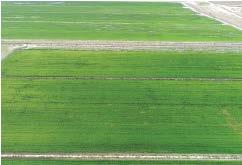
INCREASING PRODUCTIVITY IN RICE CROPS BY SOWING RICE INTO LEGUMES; REDUCING THE RELIANCE ON SYNTHETIC FERTILISERS, AND IMPROVING SOIL HEALTH AND WEED CONTROL IN A RICE FARMING SYSTEM THROUGH THE INCLUSION OF LEGUMES.
KEY LEARNINGS
• Legumes do provide additional nitrogen to the rice crop and improve NUE.
• Yields from legume-based crops were higher than the average yields.
• Legume based crops allow flexibility in management and sowing methods.
• Uneven establishment or uniformity of establihsed crops does create variability in rice crops.
OBJECTIVE

To increase rice productivity, through less fertiliser input costs, improved soil health and structure while maintaining paddock trafficability (consolidated firm seedbed).
Rice in the Murray Valley was traditionally grown in rotation with legumes (primarily sub clover) up to the millennium drought in the early 2000’s. The benefit form this was reduced nitrogen requirements and soil health. Over the last couple of years some growers have reintroduced legumes (primarily peas and vetch) into their cropping rotation and sown rice crops directly into the stubbles.
There are 32 paddocks in the EMV involved in this analysis and the legumes were vetch, sub clover and shaftal clover. All were annual crops except for the sub clover, that had been in for multiple years. A summary of the crops analysed are below.
ACTION
• The management of the legumes has been different from farm to farm, including spray fallow, spray graze and removing through making hay.
• Average N addition.
These crops had a higher N index than the average for C23, but all crops had a lower N index than the previous five year average due to the cool season and was reflected in overall yields in C23. The N peak was later in C23 for all crops compared to the previous 5-year average. The legume-based crops had a yield difference of over 1 tonne when compared to the EMV average as can be seen in the table below. It should be noted this is a small data set.
While the average yield was higher, there any nitrogen benefit from the legumes? As all crops had urea applied, one way to look at this, was the NUE of the legume-based crops compared to conventional crops. Table 2 shows legume-based crops had a significantly better NUE in both varieties.
Table 2: Comparing the NUE of legume-based crops and the Eastern Murray Valley crops.

Nitrogen use efficiency is calculated by the total nitrogen (kg/ha) applied to a paddock, divided by the total yield for the paddock (t/ha) NUE = N rate / Yield. The lower the NUE is, the more efficient the nitrogen use was for the paddock.

Figure 1 - Comparing the Nitrogen Index of CY23 rice crops sown into legumes to the last 5 years and the CY23 V071 crops in the Murray Valley

Not only did the legume-based crops have a higher NUE, but they also had a higher uptake of N compared to all EMV V071 crops in CY23. One reason for this is a result of the mineralisation on N over time, which makes N more readily available. The graph also shows N uptake was lower than the previous 5-year average, which is most likely due to the function of a colder spring/summer. Release of mineral N is influenced by soil water content, temperature and pH, the amount of residues returned to the soil after a legume phase, the ‘quality’ (particularly C:N ratio) of those residues, and the length of the fallow period between the end of the legume phase and sowing the next crop. The N benefit from legumes can last for more than one year.

Figure 2 - Comparing the Nitrogen Index of rice crops sown into different legumes and stubble management
The N index maps show that where biomass was removed (through grazing or hay) the N uptake was lower. This would be due to N fixation peaks at flowering (maximum amount of biomass produced), so removal of biomass prior to flowering such as grazing will reduce the amount of organic N available. Also crop legume residues can still contain significant amounts of fixed N even after a large amount of N is removed in grain at harvest. The graph also shows the benefit of more than one year of legumes as the sub clover paddock had the highest N index of all paddocks.
One of the issues with some of the legume crops was the variability in the establishment of the Vetch due to the wet year or consistency of the clovers due to grazing preference and competition from grasses and weeds. This did create some variation in dry matter (DM) which will affect the amount of N fixed. This was demonstrated from some Vetch DM cuts, which showed a range from 1.34t/ha to 5.3t/ ha. If one assumed 25kg/N was fixed in the Vetch crops per tonne of DM, this would range from 33.5kg N/Ha to 132kg N/Ha. The variability was measured between paddocks (Table 3) and within paddocks (Table 4). The variation was also detected in NDVI’s.
Table 3 (left) - Estimated vetch dry matter cuts in rice paddocks in the EMV showed a wide variance in dry matter.
A9 North 1 215g 21% 1.8t/ha
A9 North 2 160g 21% 1.34t/ha
A10 North 326g 21% 2.74t/ha
M13- 1 254g 21% 2.13t/ha
M13 -2 471g 21% 3.96t/ha
E18 632g 21% 5.3t/ha
Composite Sample High growth area from NDVI (A)
Average Fresh Weight (g/0.2m2)
NIR Analysis Results
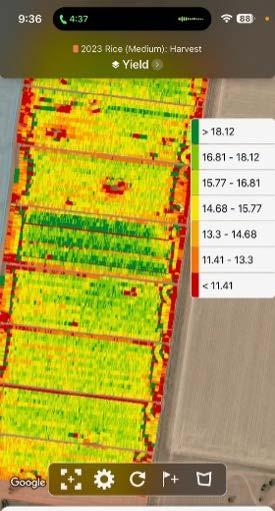
Table 4 (below) - Demonstrating the variance in fresh weight and N uptake within the same paddock that has been a sub clover paddock for over 10 years (Sample A and B) and had 160kg/ha of urea applied pre-permanent water. Within the paddock there was a section (Sample C) that received no urea pre permanent water as a control.
Average growth area from NDVI (B)
Low growth area and no urea applied prior to PI (C)

Another challenge with sowing rice into legumes is assessing the amount of nitrogen required to maximise yields. To address this, strip trials were conducted on two farms. This is an excellent guide for following crops. The yield map below shows as the rate of prepermanent water urea increased from 260kg/ha (base rate) to 320/ kg/ha the yield increased. The strip trials are framed on the yield map with the base rate of 260kg/ha on either side of the strips and 280kg/ ha is the bottom strip, then 300kg/ha and 320kg/ha on the top strip.
Acknowledgements for information and data:
Stacey Doolan, Nutrien, Finley
James Brinkhoff, Applied Agricultural Remote Sensing Centre, UNE.
Supported by AgriFutures Australia PRO-013078
EMV Rice Growers
Nitrogen: Using Legumes to Grow Your Own
Mark Peoples, Tony Swan and John Angus, CSIRO Plant Industry, Canberra ACT

GROWER
CATCHMENT
RICE HA
ADVISOR
EXPLORING WHAT HAPPENS IF YOU DON’T APPLY PRE-PERMENANT WATER (PRE-PW) NITROGEN IN AERIAL SOWN CROPS
KEY LEARNINGS
• The management practice of applying nitrogen Pre-PW will result in higher yields, and better nitrogen use efficiency.
• When this is not possible, applying nitrogen Post-PW will also work. However, yield expectations should be adjusted and/or higher rates applied to compensate for losses lowered and higher nitrogen use should be expected.
• See outcome graphs for Post-Permanent Water (Post-PW) N yield averages vs sowing timings.
OBJECTIVE

To evaluate the efficiency of applying nitrogen to rice crops post permanent water. This case study captures data and learnings from commercial farms in the Murray Valley in CY23.
OVERVIEW
Wet weather conditions at the start of the CY23 season made best management practice a challenge to accomplish and, in many cases, not achievable. As there is a clear correlation between high yield potential and sowing within the sowing window, many aerial growers decided to sow rice straight into bays already filled with water to try establishing rice with no fertiliser.
The crops were able to be established without fertiliser. In these crops, urea was applied mid-season. Growers had two choices as to how to apply the urea:
1) Apply the urea by air into the water (with one or two split applications) or,
2) Carry out a mid-season dry down and applying broadcast fertiliser onto dry soil (at least 3cm of dry soil) before refilling the bays.
Although we were unable to gather adequate data to compare the different methods, we have enough data to compare the yields and the NUE of applying nitrogen Post-PW vs best management practice (Pre-PW).
Research and data from commercial CY23 rice crops show applying nitrogen Pre-PW will result in higher yields as seen in Table 1.

Post-PW nitrogen use efficiency was around 50% more than Pre-PW for both regions altogether.

Summary of yield by sowing week for Post-PW N
V071 and Sherpa:
17 WMV growers (some growers had both varieties)
10 V071 growers
11 Sherpa growers
Rice crops that had urea applied Pre-PW yielded more than those that had urea applied Post-PW in the EMV and the WMV.
V071 was the higher yielding variety for Post-PW N in both regions.

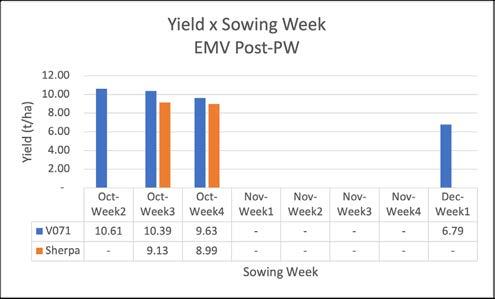
Summary of yield by sowing week for Post-PW N
V071 and Sherpa:
5 EMV growers
4 V071 growers
1 Sherpa grower


GROWER
CATCHMENT
RICE HA
ADVISOR
THE PROS AND CONS OF AN OPPORTUNISTIC RATOON
WHAT ARE RATOON CROPS?
A ratoon crop is a crop that is grown from the stubble or roots of a previous crops without re-planting.
WHY DOES THIS HAPPEN?
The CY23 season saw significant rainfall flooding across the rice growing footprint from September to December 2022. This significantly impacted growers’ ability to prepare paddocks and plant rice within the ideal window.

During this time growers were focussing on draining water from the winter cropping paddocks and were using their CY22 rice stubble paddocks as water storages, since rural drainage and on farm storages were at capacity.
As a result some of these rice stubble paddocks ratooned and gave growers an opportunity to persist with a ratoon rice crop when water levels subsided.
KEY LEARNINGS
• Opus ratoons the best out of our varieties followed by Koshihikari.
• Herbicide strategies were limited but some flexibility in the program gave growers options.
• It was an economical exercise increasing rice production (particularly Opus) in a challenging season.
• Standard nitrogen fertiliser rates or slightly higher are required to generate moderate yields.
• CY23 opus ratoon crops were economical to the grower when approached with a conservative yield estimate, exercised cost control and rationed inputs.
Despite the unconventional preparation which lead to the establishment of these crops, the outcome proved to be economical in a year where water was plentiful (due to floods and temporary water sub $40/ML) especially when approached with a conservative yield estimate, exercised cost control and rationed inputs accordingly.
The following comments provide a quick summary of some of the learnings and experiences from the growers who pursued growing a ratoon crop:
• Opus followed by Koshihikari were the best ratooning varieties.
• CY22 drill sown paddocks which were burnt after the CY22 harvest in the Autumn or early Winter produced more persistent crops.
• Given the paddocks were used as water storages and had deep water and de-oxygenated water at times, the bottom bays drowned a lot of ratoon rice and in some cases growers should have abandoned the bottom bay/s.
• Herbicide strategies were limited, the three-way mix was not possible, some foundation herbicide strategies were used. Nearly all growers used Agixa as a salvage spray.
• Barnyard grass was the biggest weed pressure.
• Snails were prevalent and all growers treated crops for snails.
• Nitrogen strategies varied, no pre-plant starter fertiliser was used, mid-season top dressing was common, either by drying the field and trafficking it with a ground rig, or flying urea into water by plane followed by top dressing at PI.
• In hindsight growers said they could of used more Nitrogen to increase yield, however with extremely high input costs for Nitrogen (circa $1200/t for urea) and challenging conditions rates between 300-370kg/ha urea for Opus were common and economical.
• Most growers hit PI by the second week of January despite being concerned that it would be very variable through the crop.
• As crop progressed through the reproduction and grain fill stage, they evened up in maturity making drainage decisions more distinct than initially expected.
• Flood water or off allocation water sustained most crops through to late December
• Reduced input cost, through no seed and sowing costs and minimal operations in crop.
• Good return on investment.
• Yields for the area that was harvested Opus ranged between 10.2-7.3t/ha compared an industry average of 7.95t/ha in CY23.
• Crops matured evenly, didn’t lodge and were easy to harvest.
• Paddy Vision Quality scores were good.
• Harvest was on time and all at moisture levels above 17.6%.
• Given the circumstances was worth doing.
• Bottom bays accumulated dirty flood water, de-oxygenated water and some chemical residue resulting in poor plant populations. A number of growers cut their bottom bay/s off.
• Efficiently Nitrogen application was a challenge. The better crops managed to dry down for top dressing with a ground rig, then fill up. However flying urea in mid-season was also common practice.
• Wheel ruts and bog marks from CY22 had poor establishment.
• Paddocks which had wheel ruts and bog marks from the CY22 season were rough to harvest.
Despite having impact from wheel tracks during establishment of a ratoon Opus crop, and some variability across bays, reasonable stand allowed a viable economical outcome for the season.


CATCHMENT
RICE HA
ADVISOR
ANDREW BRAIN
EXPLORING THE DIFFERENT METHODS OF APPLYING NITROGEN TO RICE CROPS IN A WET YEAR.
KEY LEARNINGS
• In this case study, the mid-season dry down to apply nitrogen was the most efficient use of nitrogen at 15.1N/t compared to predrilling and split application into water that had a NUE of 17.35 N/t and 17.3 N/t respectively.
• Sowing crops in the window has a bigger impact on yield than N application methods.
OBJECTIVE

To showcase the results of sowing crops within the sowing window, highlighting that this has a bigger impact on yield than methods centred on applying nitrogen.
OVERVIEW
Andrew Brain, like all growers in CY23, faced the challenges posed by continual rain fall in October. Andrew had a target start date for aerial sowing his three crops (P1, P2 & P5) of 10 October. Andrew normally follows best practice by pre drilling urea 7-10cm prior to filling up with water and sowing. However the following rainfall events put a stop to this: Date
05 - 08/10/2022
30mm
12 - 13/10/2022 68mm
21/10/2022 4mm
23 - 25/10/2022 80mm
As the ground preparation for the three paddocks was completed in September, the decision was made to fill up P1 (Sherpa) & P2 (V071) and aerial sow them at 140kg/ha on 27 October and 18 October respectively, with no fertiliser. P5 (Sherpa) was aerial sown at 140kg/ha outside the sowing window on 13 November.
The reason this crop was sown later was to enable the nitrogen to be predrilled prior to sowing to reduce the risk of the unknown impacts of applying nitrogen. This enabled Rice Extension to follow the different practices and report on the outcomes.
For aerial crops sown without nitrogen upfront, there were two options. One was to split nitrogen applications into water and apply 20% more N than normal and the other was to do a mid-season dry down to apply the nitrogen, which is logistically challenging (especially in a wet year) but has a lower cost and higher N efficiency.
P1 had the split application of 110kg/ha urea at 3-4 leaf and 140kg/ha of urea at early tillering followed by 140 at PI.
P2 had 280kg/ha applied after 13 days of water off the paddock. The paddock was dry on about 80% of the paddock but with the need to get the water back on, the decision was made to apply the urea and accept some losses. Normal practice is 220kg/ha upfront but the higher rate was used as the paddock was rice on rice and to allow for some losses. P2 was top dressed with 150kg/ha.
P5 had 230kg/ha pre sowing and was topdressed with 100kg/ha on 16 January. This crop looked magnificent but was hit with cold sterility (see graph below) and an observation from Andrew, ”The crop was very flaggy and as soon as I got a couple of runs in I knew it wasn’t a 10t/ha crop.”
This was a consequence of sowing outside the window and PI’d around 20 January.


Table 2 - Both V071 and Sherpa crops sown outside the sowing window yielded less.
Crops can be grown successfully without applying nitrogen upfront. It is more critical that crops are sown in the sowing window.
Andrew said, “If I was doing it again, I would do the mid-season dry down method due to the higher NUE and the lower cost. The plane cost is significantly higher than using a ground rig.”
“It is important to sow in the window, as I said, I was aiming to sow just after the ute muster but it just didn’t stop raining.”


GROWER
CATCHMENT
RICE HA
ADVISOR
CHARLES & DREW MCDONALD
WMV
426.8 SOWN
296.9 HARVESTED
ANTHONY MCINERNEY
UNDERSTANDING HOW GROWERS ADAPTED TO EXTREME FLOODING CONDITIONS AT ESTABLISHMENT IN THE WMV
KEY LEARNINGS
• Rice can survive in two feet of flooded water for eight weeks.
• In challenging years such as CY23, it’s key to have more than one plan to sow your rice in case ‘Plan A’ fails.
• Aerial sowing Sherpa into canola stubble in the first week of December recorded a higher yield than drill sowing viand into canola stubble in the WMV in CY23 (Viand yielded 4.83t/ ha).
OBJECTIVE

The objective of this case study was to test different options when Plan A (best management practice) is not possible.
Plan A: To have 280ha aerial sown with best management practice on fresh paddocks.
OVERVIEW
The McDonalds’ achieved their ‘Plan A’, getting 280ha of V071 sown with best management practice by 29 October. However, 160ha (paddocks C1, 2, 3, 4, 5, 6) became flooded with no access to the paddocks from deep creek flood water within the first week of sowing. The remaining 120ha (paddocks C7, 8, 9) were also struggling with deep water on bays from excess rain and nowhere to drain the water. Even though Plan A had been accomplished, extreme flood conditions threatened the survival of the entirety of their rice crop during establishment.


C1-6: 27 Oct | 9 days after sowing Extreme flood affected paddocks C1-6

29 Oct: Aerial photo of C1-6 and C7-9
When the floods cut off access to 160ha of their rice crop, the chances of the whole crop surviving were minimal. To compensate for their potential loss, the McDonalds’ decided to sow more rice on their other farm that had last year’s unburnt rice stubble and a canola crop.
On the rice-on rice paddocks (W7, 8, 9), they burnt the stubble, applied a knockdown, filled up and aerial sowed Sherpa without starter fertiliser. The canola (W10) was harvested with water in the bays, then aerial sown with Sherpa straight after harvest without starter fertiliser.



Both scenarios had urea applied five weeks after their sowing date. The rice on rice paddock had 300kg/ha urea and the canola paddock had 250kg/ha urea with one aerial pass. The rest of the season was treated the same as a normal season with PI fertiliser rates.
The creek-flooded rice was underwater for eight weeks from 29 October. The water depth varied from 2-3 feet of water. Rice survived with a water depth of 2 feet but didn’t with a water depth of 3 feet. This left 41ha of rice that survived out of the 160ha that was sown in paddocks C1 to C6. For the remainder of the season, the only action they carried out was to spray the paddocks with basagran and MCPA to control the heavy dirty dora populations.


30 Nov: Creek-flooded rice, long and spindly, only at 2-3 leaf stage

Indicator of water depth
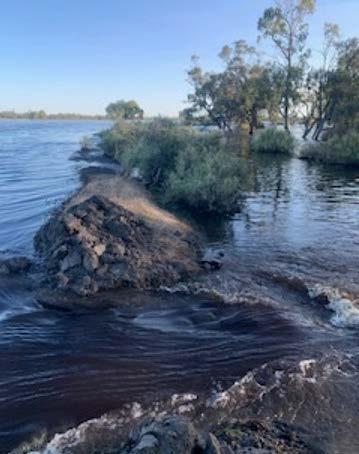
1 Dec: letting flooded water go off bays
COMPARISON OF ALL SITUATIONS ON 6 JANUARY TO SEE THE DIFFERENT STAGES: Creek-flooded rice:


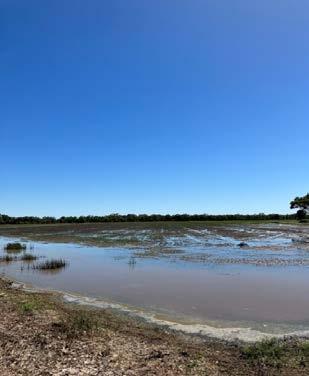




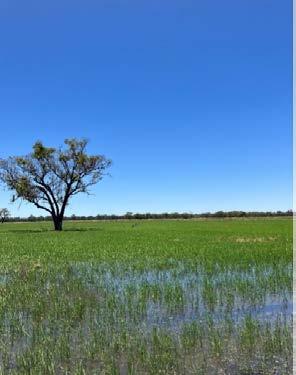


The McDonalds’ were able to harvest 296.9ha of rice from the 416.6ha they had sown. Their crops were harvested at a reasonable time with the start of harvest on 27 April and the last day of harvest 24 May.
One of the key success stories from this case study would have to be the canola stubble rice. It yielded 7.2t/ha despite being sown on 5 December without any fertiliser underneath. Although these practices outlined in the case study are not best management practices, they provide an alternative if ‘Plan A’ does not work out. This case study should be used as a guide for growers and agronomists if a similar scenario occurs again.
A summary of the season for each paddock and scenario is outlined in the table below:
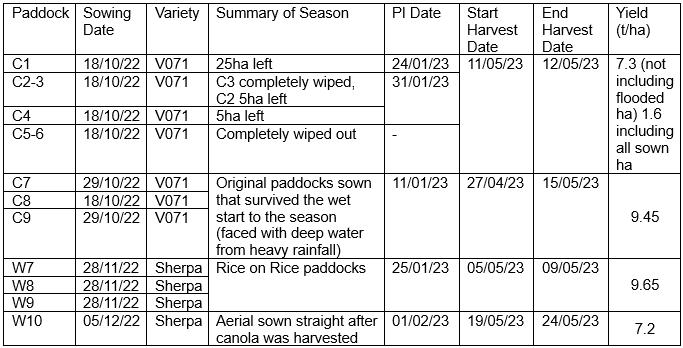


GROWER
CATCHMENT
RICE HA
COMPANY

MAKING OPPORTUNITIES - ONE GROWER’S EXPERIENCE FOR THE CY23 RICE CROP
KEY LEARNINGS
• Make decisions early - delay means missed opportunities.
• Ensure good weed strategy when establishing rice.
• Crop nutrition can come later. Best management practice is optimum. However, it is not the only path to good results.
KEY FIELD DATA FOR CY23 SEASON


Aerial PG – aerial pre-germinated, DB – dry broadcast, Starter P = Granulock Z, # ‘2 Applications’ – 125kg/ha urea applied early tiller, 125kg/ha late tiller flown into water (and final application at PI)
* Dry seed was spread onto wet ground then treated like a drill down crop with specific herbicide management depending on crop stage and weed spectrum This varied by the paddock.
OBEJCTIVE
Identify actions used to establish rice in a timely manner when conventional wisdom and best management practices are not an option.
The CY23 rice preparation can best be summarised by the following cumulative rainfall chart:
On the back of a wet winter, over 350mm of rain fell in the critical preparation and planting window throughout spring, with very limited opportunities to work, spray or plant paddocks.
Drew vividly remembers standing in his shed on 10 October with 100mm rain falling on the roof, and only 110ha of his planned 630ha of rice planted and thinking, ‘It’s going to take me a month to six weeks to even start preparation, and that’s if we have no more rain.’

He made the decision then and there to go and start boarding up bays to capture water rather than try and drain it off - and set about confirming weed control, nutrition and planting options for his partially prepared and unfertilised paddocks. Three weeks, and another 200mm of rain later, all 630ha was in the ground.
Throughout winter Drew took every opportunity between rain events to prepare paddocks. All rice stubble paddocks, totalling 315ha and mulched and burnt soon after the previous harvest, were chiselled then scarified. The other 315ha of fallow ground was burnt wheat stubble from the previous year, boarded and kept clean with knockdown herbicides over winter.
Planting
Only 28ha were conventionally drilled with 150kg Granulock Z on 5 October, just as the rain started falling again. Treated conventionally and on time this was the highest yielding block at 13.1t/ha. As the rest of the fallow was so wet, Drew broadcast dry seed onto the wet ground when the opportunity presented itself between the 20 October and the 28 October, and let the rain do the rest. Establishment success was mixed as the ground was very smooth with plant populations variable. These ranged between 50 – 400plants/m2 – the higher rate in wheel tracks and clumps. Drew considers boarding a disadvantage this season and having a rougher seedbed (slightly worked with chisel points as an example) would have been a lot more effective. There was a lot of seed movement, some seed sink and surface seed mortality, with section re-sown a few weeks after the initial planting. Yields ranged from 12.0t/ha for the earlier block, and 11.0t/ha for the later one.
Another 43ha block, developed in the previous season and planted the same way but under flood water, was not able to be planted for another three weeks. With seedling populations very patchy and many areas below 40 plants/m2, this required resowing (with the plane) two weeks after the initial sowing. Resowing success was mixed, and this was the lowest yielding block at 9.5t/ha.

The last block was planted 4 December. Drew changed from V071 to Sherpa and was able to conventionally dry broadcast with 150kg Granulock Z and predrilled urea at 300kg applied prior to spreading seed, with conventional aerial sowing herbicide strategy. Being so late, Drew was happy enough with the 10.7t/ha yield however there were a lot of flatheads in the crop. However - as this was able to be planted conventionally, this is the timeframe Drew considers would have been the next best opportunity to plant. From the time he made the decision to change tactics to the time he physically could have gotten back on the ground, Drew had planted an additional 440ha.
As the fallow blocks were kept clean all winter, weed pressure was consistent but not out of control. However, flexibility was very important, with herbicide strategies varied and tailored to relevant weed pressure and rice stage. Agixa/Stomp was the main method on some blocks (followed by 300kg urea then filled up). The recently developed block posed more of a challenge, with bays filled and Ordram/ Taipan applied. This bought time as bays needed to be drained again (on farm) to allow rice to anchor and develop. Depending on rice stage and weather, this then gave flexibility to use Saturn either bare earth or into water, or other chemicals depending on weed spectrum. (Salvage MCPA spray is not considered an option due to susceptible crops around the area). In this instance bays were topped up again for a Saturn application, bays drained again to allow rice to get away, 300kg urea applied then bays filled again. While there was some dirty dora escapes, overall weed control was more than adequate.

Where ground trafficability was not an option, there was no opportunity for pre-drilled or pre permanent water application of urea. With the best management tool not available, Drew flew urea into the water at mid and late tiller, then again at PI. While less efficient (and more costly) this got urea where it was needed and added to flexibility and effectiveness of weed control.
Of the stubble area, there was only opportunity for 85ha to be prepared and fertilised conventionally, with 150kg of Granulock Z spread and 300kg urea drilled prior to rolling. This was dry broadcast planted on 5 October, with 130-180 established plants/m2 and final yield of 12.8t/ha.
Another area of 130ha, previously worked twice over winter, was simply boarded up with rainfall flooding paddock, and aerial sown on 28 October with pre-germinated V071 at 170kg/ha, no fertiliser. The rough surface, while making weed control challenging, was an advantage for establishment with minimal seed movement. Also, residual stubble and root material held the soil together and kept water clear. Establishment on these areas were excellent, with plant populations 200 – 300 plants/m2 consistently across the whole area. This yielded 12.6t/ha
The last block of 100ha was treated similarly, however a very late C22 harvest, and extremely wet paddock meant workings were very rough. Population was still adequate at 100-150plants/m2 but deeper water was required for early weed control. This needed to be drained as continuing cool weather meant rice was struggling. This block, although planted at the same time as the one above was delayed and yielded 1.7t/ha less at 10.9t/ha.
Crop Nutrition and Weed Control
Drew was very strategic with both weed control and nitrogen application in these stubble blocks. The very wet blocks meant no knockdown herbicide was applied. The cold weather kept existing barnyard and dirty dora to a small size, but he knew it was an issue. At fill up (by rainfall) he aerially applied a mix of Ordram/Taipan/Magister to give him time, the soluble Magister to move up into clods that may be exposed above the water surface. The initial plan for both nitrogen efficiency and cost, was to dry blocks down at early to mid-tillering, spray any surviving weeds present, spread urea and fill up again. (With a good phosphorus history, Drew was not worried about phosphorus for the season).
However, with continuing rain, a dual weed spectrum of mostly dirty dora and some barnyard grass, the time required to drain, dry paddocks out and fill up again, the challenge seemed insurmountable and the task impractical.
Again – once the decision was made to keep the water on, Drew was very proactive in looking for the best solution under the circumstances. In a meeting with Rice Extension, nutrition research agronomist Brian Dunn (DPI) and herbicide specialist Malcolm Taylor (Agropraisals), it was decided a combined herbicide and nutrition strategy approach was necessary. Added applications of Saturn at the relevant rice growth stage, and three urea applications at early and late tiller, then again at PI, provided both adequate weed control and nutrition. Drew was looking to apply an extra 150kg/ha urea due to a less efficient application method. However with high plant population and the crop looking thick and bulky he cut this back.
The results - 12.6t/ha and 10.9t/ha yields compared to not getting the paddock in at all, and an overall average yield across the whole area of 11.6t/ha.
• There is a solution – the combined experience of growers, advisors, extension and researchers helped every time. Utilise these available services wherever possible.
• If the decision was not made to change management plans and go with the continuing wet weather on 10 October, the next conventional planting opportunity was 4 December. In this timeframe, 440ha was planted and established.
• Final success comes from managing timeliness, weed control, plant establishment and nutrition, both in that order and in relationship with one another.



GROWER
CATCHMENT
RICE HA COMPANY
ACHIEVING EXCELLENT YIELDS IN A CHALLENGING SEASON
KEY LEARNINGS
• Excellent layout and early preparation provide maximum flexibility
• Planting within the ideal window of time produces best results.
• Timely and even establishment is critical to high yields.
KEY FIELD DATA FOR CY23 SEASON
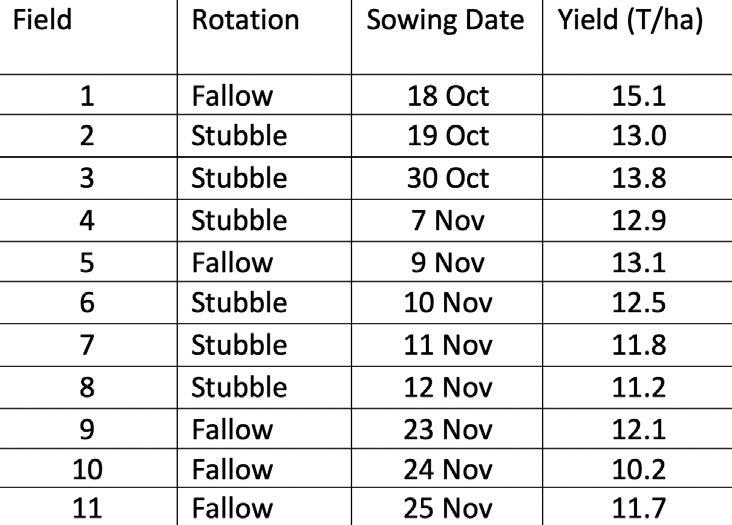

Stubble is Rice stubble from previous season. Fields 9-11 were on a new block that required some extra work to ensure an even seedbed so were the last planted.
Consistent high yielding crops can be achieved even in adverse seasons, through timing and management. Both factors are more effective and flexible with the right irrigation layout and access to the right machinery for the right job.
Preparation for CY23 was very difficult with extremely wet conditions during the preparation and planting window. Only 8% of the MIA rice crops were planted in the ideal planting window. While their planting window was extended compared to usual, the Atkinson Family were able to achieve an individual exceptional high yield of 15.1t/ha on a 60ha paddock and averaged 12.5t/ha across 550ha.
The Atkinsons consider their irrigation layout as the foundation of their operation. This includes 30ML/ day flow rates, 900mm pipes and matching channel infrastructure, 120mm steps between bays and drive through bankless channels so all turning is done on roadways rather than in field. This ensures water is on and off in under 24 hours in the 8 – 12 ha bays.
Preparation was less than ideal for this season, and they admit that establishment rains ensured an even and consistent plant stand even in unworked rice stubble. However, early preparation, including fallow ground fully prepared in autumn of the previous season and ‘back-to-back’ rice stubble ground that was burnt early in September, meant knockdown spray and planting operations could be achieved in a relatively timely manner.
Having the fallow area prepared in autumn (worked, boarded and polished if required) meant a firm, consolidated seed bed that enabled trafficability and excellent establishment. Drill planting at 130kg/ha of V071 (slightly higher than their usual 120kg/ha due to adverse conditions) ensured a plant stand of between 160 – 200 plants/m2
The stubble ground preparation started even before this. The previous crop was established in a boarded and polished seedbed and all last season operations (including harvest) were performed by driving through bankless channels with turning on roadways to minimise compaction and wheel marks and ensure even drainage. Stubble ground was therefore relatively unmarked from the previous harvest, so a burn of dry standing stubble in September enabled planting directly into the unworked ground.
Due to planting conditions, the Atkinsons still planted into a later window than they would have liked. In order of planting date and under similar management, yield generally declined at a rate of approximately 0.6 t/ha/week outside of the ideal window.


THE 15T/HA CROP
Across the industry the average yield was down by 12% on the previous 5-year average due to a late start and cooler than average summer. Despite this, there were some exceptional yields in all areas of 13 and 14t/ha, with the Atkinson’s achieving 15.1t/ha in a 60ha field.
• Layout as described above.
• Lasered last season with 150mm topsoiling where required.
• Fallow over winter period.
• Drill planted (disc) into clean (sprayed) seedbed at 130kg/ha on 18/10/22 with 180kg/ha Rice Bouncer fertiliser (8N:17P:7S) at 200mm row spacing.
• Germinated on rain, 3-way mix applied.
• Flushed as worried about crusting then followed two days later with 70mm rain.
• Established plant stand of between 160 – 220 plants/m2. Very consistent and even.
• Applied 100kg/ha Gran Am at 3 leaf stage.
• Applied 300kg Urea at early tillering, 2L Agixa and filled up 8th December.
• Applied 130kg/ha of Urea at PI on the 14th of January.
• 250mm depth of water applied 2 weeks after PI, temperature graph below shows cold periods experienced on this field during critical microspore period.
• Drained 28th March and harvest commenced 17th April (Note this was a seed crop that requires delivery below 20% moisture. Crop was at 22% 6th April).
• Final Yield 15.1t/ha.
• Nitrogen use 15.2kgN/T grain – see below.

This is a figure to indicate the effectiveness and efficiency of nitrogen application. In the CY21 and CY22 seasons it was 17kgN/T grain produced, this season over 19kgN/T, a reflection of lower yields. Adequate N is required for high yields, however too high can create lodging issues and increased cold susceptibility, often with lower yields, difficult harvest and greater input costs.
If your figure is significantly higher than the assumed benchmark of 17kgN/T, this is an indication of inefficient application methods (high N losses) or lower than potential yield due to another factor other than N.
If your figure is lower this is an indication of available organic N in your soil and measure of soil organic fertility – such as a legume rotation or high organic carbon content.

From preparation and planting through to drainage and harvest, timeliness is everything when it comes to achieving consistently high yields.
Excellent irrigation layout gives more options and greater flexibility to achieve ideal timing, particularly in adverse conditions such as experienced this season.

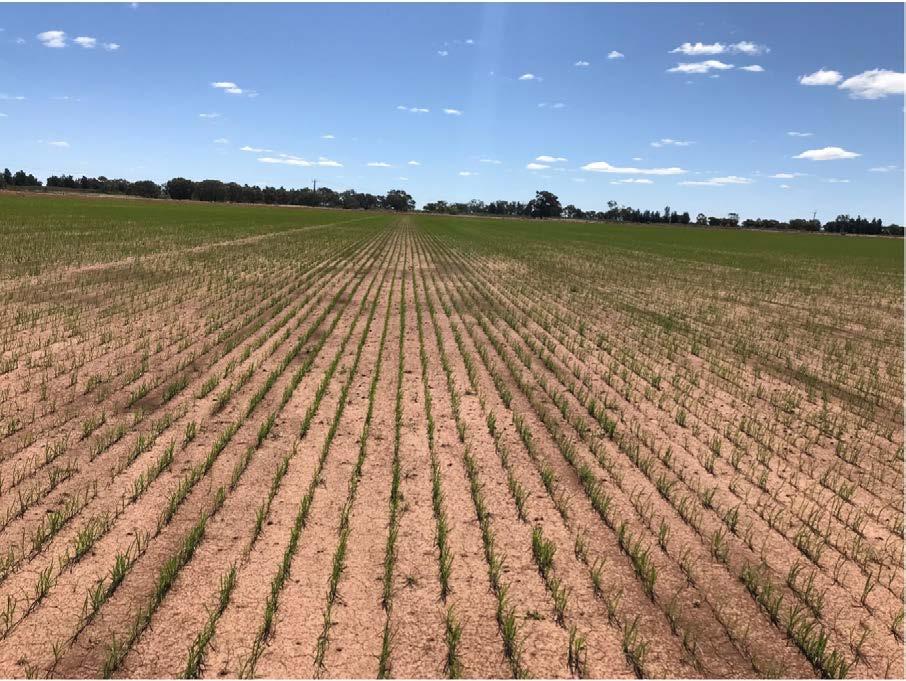

WHAT CAUSED COMPLETE FAILURES?
Every region had low yielding crops as well as a few crops not worth harvesting. Not including some crops, particularly in the Western Murray Valley, that were completely inundated with deep and uncontrolled flood waters, these failed crops had a few things in common.
Some crops failed due to poor establishment. Usually, they were aerial sown into a poorly burnt stubble worked into the ground. This created dirty water and a high organic load, ideal for snails and blood worms.
Mostly however, the failed crops were very late, planted into mid-December. They were then pushed into an even later window (or PI date) with late permanent water applications into late January and with high nitrogen rates. High N rates both delay maturity and increase the susceptibility to cold induced sterility at pollen microspore.
Conversely there were some late planted crops that performed well (10-11t/ha) using conservative N rates and sown to enhance speed of maturity, usually aerial or dry broadcast planted.
The lesson – PI and microspore date is key. If you’re planting late, lower expectations, be conservative with N and vigilant with water management to minimise delays in maturity.
I GOT A GREAT ESTABLISHMENT THIS YEAR FLYING UNGERMINATED SEED INTO FLOODED BAYS. WHY DO I BOTHER USUALLY PRE-GERMINATING SEED FOR MY AERIAL SOWN CROPS?

It’s all about the oxygen in the water and the state of the soil. Some people aerial sow with ungerminated seed every year and wonder why others pre-germinate the seed. Others try to plant ungerminated seed and need to resow.
The seed requires oxygen to germinate. Cold water holds more oxygen than warm water, rainfall is highly oxygenated compared to flood water, moving water generally has more oxygen than stagnant water. So, planting into areas that were filled up by rainfall and boarded up usually had good results with ungerminated seed. Stagnant and dirty flooded water had less success.
In addition, the state of preparation and soil was an important factor. A rough seedbed with a lot of previous crop root matter and some stubble (winter crop or rice) held the soil together. Seed was able to germinate and anchor relatively quickly. Where soil was more slakey, a greater amount of seed sink occurred, or soil melted over the seed. Research has shown oxygen depletes to almost zero with only 2mm of soil depth, so establishment was much patchier where the ungerminated seed was buried.
MY DRILL SOWN CROP WAS FLOODED FOR TWO WEEKS BEFORE EMERGENCE, BUT STILL CAME THROUGH OK. WHY DO WE NEED TO NORMALLY GET THE WATER ON AND OFF QUICKLY FOR BEST ESTABLISHMENT?
In these instances, the cold temperature was our friend. As mentioned above, cold water holds more oxygen than warm water, so there was still enough for the seed to respire and not ‘drown’. In addition, the colder temperatures meant seed respiration was slower, so there was not as much demand for oxygen. Under hotter conditions (normal seasons) it is unlikely the drill sown seed would have survived such a period of inundation.
WHY WAS IT RECOMMENDED NOT TO BOTHER APPLYING PHOSPHORUS THIS SEASON FOR AERIAL SOWN CROPS?
Phosphorus (P) is normally applied either drilled in or spread prior to a working. However due to the extremely wet preparation conditions and untrafficable ground, fertiliser was not able to be applied conventionally. It is important to bury as much of the P as possible, as P on the surface can promote slime growth under the right conditions (and in some instances where P was applied aerially and not able to be worked in, this was indeed the case). P under flooded (anaerobic) conditions chemically changes form and becomes more available to the plant. So, where paddocks have a fair P history (soil tests above 2040mg/kg) growers could be confident that P would not be limiting for this season in their aerial sown crops.
WHAT WORKED BETTER – SPREADING UREA ONTO WET GROUND PRIOR TO FILL UP, OR FLYING UREA INTO WATER FOR AERIAL SOWN CROPS?
Neither are ideal and best management is always to drill the urea prior to fill up. This is by far the most efficient method of application. However, ‘Plan A’ didn’t exist for many growers this season. ‘Plan B’ of flying urea into flooded bays with multiple applications at early tiller, late tiller and again at PI is a much better option than spreading onto wet soil. Spreading urea onto wet ground then filling up is highly inefficient as the saturated soil means the urea will not wash into and bind to soil particles. This means the urea is dissolved in the water with no plant material to absorb it. This urea will eventually dissipate as nitrogen gas into the atmosphere. Flying urea into a flooded developing crop is comparatively more efficient as the crop has the ability to absorb a percentage of the dissolved urea before it dissipates as a gas. While this has added application costs, yield results were comparable to conventionally fertilised crops.
A combination of a very mild winter and wet spring saw 12 either ratoon or self-seeded crops this season that were managed through to harvest. Most were Opus, some Koshihikari, and one Viand and one Reiziq crop.
Most were actually self-sown crops, as opposed to true ratoon crops, or a mixture of the two. Self-sown crops germinated from seed from last season (usually from lodged crops harvested CY22), whereas true ratoon crops (of which there were two Opus and one Koshihikari) is where last season’s rice reshot from the base of the old plant. Management for both types of crops were similar. The continual wet conditions and mild winter meant this seed (or ratoon) was able to establish.
Where plant population was of sufficient number and distributed relatively evenly, around 250kg/ha of urea was spread around early December when crops were well established, herbicide applied (usually just Agixa) and crops filled up. Yields ranged from 5t/ha to over 9t/ha, usually depending on evenness of establishment. Most growers considered anything over 3t/ha was profitable. Quality Scores did not vary significantly from the rest of the crop.
An interesting side note for the self-sown Viand crop. It established itself in early October after 100mm of rain, six weeks prior to its ideal planting window. The population was not evenly distributed with higher populations (150 plants/m2) in the header windrows from the previous season, and less than 30 plants/ m2 at the edges of the comb. Continual rain through to mid-November kept the crop growing with no N applied. The grower then purposely moisture stressed the crop to ‘slow it down’ in an attempt to ensure the PI date was in the desired early January. Permanent water was not applied until late December with N applied. This management proved a success with the PI date occurring in early January with the crop harvested mid-April, yielding 7t/ha.

PRO-013174: Quick and Easy Precision Ag Tools to Increase Rice Yield and Crop or Plant Water Use Efficiency (WUE)
Tim Neale
PROJECT OBJECTIVES
The project aims to increase rice yield and WUE by reducing crop variability and in-field anomalies.
ACTIVITIES & OUTPUTS FOR THE CY23
High resolution imagery captured - three metre high resolution imagery was captured over 98% of the rice industry with growers receiving between 5-14 high-resolution images between establishment and PI. This was used to identify agronomic issues, crop variation and in the development of zone maps for in-season variable rate applications.
ANOMALY DETECTION
Using 10 metre satellite imagery, DataFarming were able to determine the extent of Nitrogen striping on 690 rice fields. This analysis showed that 18% of fields had striping issues. Poor germination detection machine learning tools were also developed.
Rapid-EM™ Mapping – Using DataFarming electromagnetic soil mapping (EM) machines, project partners completed EM mapping for paddocks ahead of the 2024 rice season. Soil tests are being completed and this information will be integrated with existing data layers on the DataFarming platform to provide pre-plant VR soil amelioration requirements for rice fields.

In season variable rate (VR) N application - 30 fields were monitored with high-resolution and standard resolution imagery during the season in coordination with agronomists from Yenda Produce and TerraAg. These fields were monitored and imagery utilised to produce VR prescription maps for in season N application was employed.
Harvest moisture prediction tool – DataFarming has developed an algorithm to predict bay and field harvest date (and maps) based on predicted moisture content of rice; and was tested on 179 fields. Predictions were accurate to within a few days and can are completed 30-45 days prior to harvest.
1) Release of Rapid Zoning and Rapid-EM™ tools enabling growers and agronomists to create:
• Pre-plant variable rate soil amelioration prescriptions using EM and soil tests;
• Variable rate seeding and fertiliser prescriptions at planting time; and
• Real-time, in-season variable rate Nitrogen layers using satellite imagery provided by the DataFarming platform, specifically tailored for rice production.
2) Release of harvest moisture prediction tool – provides predicted harvest timing at a bay and field level for agronomists, farmers, and contractors. Real-time maps of predicted grain moisture content will also be provided.
Real-time remote-sensing based monitoring for the rice industry
James Brinkhoff, Applied Agricultural Remote Sensing Centre, University of New England
1) Predict start-of-season and permanent water dates per field.
2) Predict end-of-season grain moisture vs. time, supporting drainage and harvest timing decisions.
3) Identify growth stages of each field, including panicle initiation, flowering, and maturity
4) Produce real-time information on current rice growth versus benchmarked information.
5) Map rice fields early in the growing season.
6) Forecast potential yield per field.
7) Combine the insights from the above objectives to perform industry-level analysis, generating information on productivity improvements through adoption of various water management strategies.
ACTIVITIES FOR THE CY23 SEASON
• Developed new PI and flowering date prediction models, using agronomy trial data from DPI. These models were more accurate than the previous growing degree days (GDD) models. They were deployed for real-time prediction.
• Collaborated with DPI on data collection from commercial sites, including large N plot trials. These data form the basis of many models (phenology, yield, grain moisture) used in this project.
• Developed yield prediction models using the SunRice Group’s 2018-2022 data.
• Validated permanent water and rice map models.
OUTPUTS FOR THE CY23 SEASON
• Developed dashboards for dissemination to all growers, showing growth curves, weather
• observations and forecasts, phenology predictions, grain moisture forecasts. Feedback on these was collected and the user interface is being upgraded for CY24.
• Delivered rice maps to the SunRice Group, which were used to check and correct growerentered fields.
• Delivered yield predictions and grain moisture forecasts to the SunRice Group.
• Provided analyses of growth curves for fields of interest to Rice Extension, including for Troy Mauger’s study on pre-rice legume crops.
• Update PI predictor model in collaboration with DPI and Trevor Peacock, as deployed on the Rice Extension website.

• The real-time remote (RTR) dashboards were used by growers and agronomists, with positive feedback received on the new and novel information, which provided additional input to management decisions.
• Automated rice mapping helped highlight fields that needed updating in MapRice, which improves the accuracy of industry databases and yield benchmarking analysis.
• Growth curves (benchmarked against industry averages) aided in-season nitrogen topdressing.
• decisions, based on whether a field was ‘ahead of the curve’ or ‘behind the curve’.
• Delivery of phenology timing predictions, together with weather forecasts, helped with timing of topdressing and with ensuring adequate water depth during microspore, particularly in instances of forecast low temperatures.
• Grain moisture forecasts helped decide on timing to collect field moisture samples, thus reducing the number of times fields needed visiting to collect samples.
• RTR dashboards are being updated by Sharon McGavin, making them much more growerfriendly and easy to navigate. These will be available for delivery to all growers in CY24.
• Sunil Jha is beginning his PhD research, initially focussing on phenology prediction using remote sensing and DPI commercial sample data, which will help further improve PI, flowering and maturity models.
• Yield forecast models are being developed, and combined with phenology models to uncover factors leading to low and high yields.

• The grain moisture forecast models are being extensively updated using the new CY23 data collected by DPI. These are bringing together remote sensing and weather forecast data to allow grain moisture to be predicted up to a month in advance.
PRJ013274: Rice weed management in Australia
Malcolm Taylor, Agropraisals Pty. Ltd.
PROJECT OBJECTIVES
To improve the versatility, reliability and sustainability of weed control practices in drill and water seeded rice.
ACTIVITIES FOR THE CY23 SEASON
A total of 14 replicated field trials were conducted in grower’s fields and dedicated research paddies in the Riverina during the CY23 season addressing the following topics: Four way mixtures in drill sown rice, Dirty Dora control in drill sown rice, Smartweed control, BASTA prior to rice emergence, AGIXA or AURA tank mixtures with STARANE and STOMP, MODDUS EVO anti-lodging treatments.
OUTPUTS FOR THE CY23 SEASON
1) SHARPEN and LONDAX appear to be safe to rice when tank mixed with GRAMOXONE plus MAGISTER plus STOMP for PFPE application (ie: after the first flush irrigation). No advantage has been demonstrated as yet for these fourth components in the treatment.
2) A BASAGRAN M60 plus LONDAX tank mixture was highly effective in controlling smartweed.
3) BASAGRAN M60 ought not be tank mixed with AGIXA due to antagonism of grass weed control. A minimum interval of seven days should pass between sequential application of these herbicides
4) BASTA was safe to rice when applied prior to crop emergence, but severely damaged any emerged seedlings.
5) Rice tolerance of AGIXA plus STARANE (+/- STOMP) was adequate, although no advantage of this combination has been demonstrated on southern Australian rice weeds. STARANE should not be tank mixed with AURA (+/- STOMP) due to excessive rice injury.
6) MODDUS EVO lowered rice panicle height when applied at the early jointing stage, but reduced rice grain yields by between 3 and 8%.
Improvements in the performance of post flush, pre-emergence herbicide mixtures in drill sown rice are anticipated. However, more efficacy data is required before recommendations can be made.
Growers can now access an effective treatment (BASAGRAN M60 + LONDAX) for smartweed control.
STARANE has a permit for rice and can be tank mixed with AGIXA when targeting northern upland rice broadleaf weeds.
Field testing of four way mixtures for drill sown rice and a return to evaluating programs for water seeded rice will continue next season.


PRO-013220: Development of an Integrated Pest Management Program for the NSW Rice Industry Mark Stevens & Jessica Hoskins, DPI Yanco
PROJECT OBJECTIVES
Project objectives were changed at the request of AgriFutures Australia in early 2023 to incorporate additional work on niclosamide for snail control in support of an APVMA Emergency Permit application for niclosamide use in the CY24 season. Current objectives are:
• Quantify the effects of Russian wheat aphid on drill sown rice and determine if control measures are justified;
• Screen 16 additional chemicals for snail control in the laboratory;
• Determine whether rice bloodworm have reduced susceptibility to alphacypermethrin (Dominex Duo®) relative to baseline levels prior to product commercialisation;
• Determine whether spray adjuvants improve the dispersion of the Grochem niclosamide formulation and whether or not they impact on target efficacy and phytotoxicity;
• Assess the impact of chlorantraniliprole (Vantacor®) on non-target beneficial insects; and
• Further develop economic threshold data for common armyworm in rice.
ACTIVITIES FOR THE CY23 SEASON
Work on Russian wheat aphid (RWA) has been completed and has shown that RWA does not have a significant impact on rice. Rice is a very poor host for RWA and aphids inoculated onto plants die within 1-2 weeks without significant reproduction, suggesting sustained populations in the field are maintained by ongoing colonisation from other crops or grasses. Plants do develop feeding marks from RWA but even when plants are artificially recolonised every few days, growth impairment is minimal, and plants recover rapidly when aphids disappear after permanent flood. Chemical control of RWA is not considered justified.

Nineteen chemicals (insecticides and some fungicides) have been screened for serendipitous activity against rice snails at a uniform rate of 3 mg AI/L (equivalent to 3 kg AI/ha in 10 cm deep water). None were found to cause any appreciable level of mortality to adult snails.
Bioassay data published in 1993 included an LC50 (the chemical concentration that kills 50% of test insects) for formulated alphacypermethrin of 0.28 µg/L, whilst data for technical betacypermethrin published in 2002 gave an LC50 of 0.63 µg/L. In 2015 the formulated alphacypermethrin bioassay was repeated and returned an LC50 of 0.45 µg/L, suggesting a slight decline in pest susceptibility, however by 2021 LC50 values for a Yanco field-collected strain had increased to 11.3 µg/L for formulated alphacypermethrin and 16.0 µg/L for technical betacypermethrin. Additional strains from different locations (Griffith, Yass, Whitton, Wagga Wagga, Ganmain, Berry Jerry State Forest) were bioassayed against formulated alphacypermethrin in 2022/23 and returned LC50 values of 5.0 – 11.6 µg/L. A further strain from suburban Melbourne collected before 2019 and maintained in continuous culture at RMIT was amongst the most susceptible (LC50 4.7 µg/L) but did not differ from the Wagga Wagga strain.
These bioassays indicate a progressive decline in the susceptibility of rice bloodworm to alphacypermethrin that does not directly correlate with the proximity of the collected strains to rice growing areas (e.g., the Whitton strain was amongst the most susceptible while the Berry Jerry State forest strain was amongst the least susceptible). Declines in susceptibility were up to 40-fold relative to 1993 data, and the most susceptible strain was still 16-fold less susceptible. The decline in susceptibility appears quite stable, as the Yass strain was cultured in the lab for eight generations and did not increase in susceptibility over that period.
Whilst alphacypermethrin use in rice may be partly responsible for the apparent development of pyrethroid resistance in the rice bloodworm, the use of pyrethroids in other crops and in urban pest control are also likely to be factors. A comparison of 2014 and 2019 Dominex Duo® formulations (after their A.I. content was analytically determined) suggests that a formulation change may also be having an impact.
Grochem wish to commercialise a niclosamide product for use against rice snails, however previous trials with a similarly sourced product showed that dispersion into the water column was an issue. We have developed an apparatus to test how various spray adjuvants affect dispersion into irrigation water, and samples are now under analysis at CSU. Two adjuvants have been tested - one significantly enhances product efficacy against snails, whilst one appears to reduce it. Phytotoxicity tests of product/ adjuvant combinations are currently being conducted. A key aspect of developing better thresholds for armyworm control is understanding the ‘panicle stripping’ that armyworms cause in the period leading up to harvest. We have been using glasshouse studies to quantify the amount of grain loss caused by panicle stripping (per armyworm per day), and whether this is density dependent. From this and other data we will be able to estimate the daily grain losses caused by given population density of late instar armyworm, predict the consequences of not treating the infestation and then identify the pest density at which treatment is justified on a cost/benefit basis.
The entomology section of the Rice Crop Protection Guide has been updated for the CY24 season and an article on RWA in rice has been submitted for the spring edition of IREC Farmers’ Newsletter. A scientific journal article on RWA is currently being prepared. Regular updates on the niclosamide work are being provided to an advisory group that includes representatives from AgriFutures Australia, the SunRice Group and Grochem.
At present there are two issues that growers need to be aware of. Firstly, our research shows that RWA is not a significant issue for rice and growers do not need to use chemicals for its management. This is consistent with opinion and practice in other rice producing countries where RWA is present (e.g., the USA).
Secondly, the apparent development of resistance to pyrethroids in rice bloodworm means that aerial sown crops treated with alphacypermethrin for bloodworm control should be closely monitored to determine whether treatment has been successful. There are several other options for bloodworm control, with fipronil seed treatments and chlorpyrifos spray applications being the most reliable.
Once the niclosamide laboratory work has been completed we will be returning largely to armyworm research. In the CY24 season we will be continuing to look at panicle stripping by armyworm in the glasshouse, and also in field cages. We hope to conduct some experiments investigating whether artificial foliar damage and foliar damage actually caused by armyworms have similar effects on plant growth, since many caterpillars have compounds in their saliva that lead to changes in plant physiology and result in more growth impairment than that caused by corresponding levels of artificial leaf damage. Calibrated efficacy spray tests on common armyworm with chlorantraniliprole and emamectin benzoate will also be conducted to determine appropriate rates for future commercial-scale evaluation. If the industry is successful in getting an APVMA Emergency Permit for niclosamide, these objectives may need to be modified to incorporate efficacy and residue monitoring in niclosamide-treated crops.

PRO-013235: Agronomy and remote sensing to maximise rice water productivity
Brian Dunn, Tina Dunn, Alex Schultz and Josh Hart, Department of Primary Industries
PROJECT OBJECTIVES
• Provide rice growers with best management practice guidelines for current and new rice varieties grown under the diverse range of water management practices and regions.
• Collect crop phenology data to develop and update models for panicle initiation and maturity. Provide valuable information to growers on nitrogen management and support the PI Tissue Test service with accurate NIR calibrations and nitrogen topdressing recommendations.
The project had a successful rice season with 14 rice variety and nitrogen experiments established and completed. The experiments included extensive testing of V071 compared to the standard variety Reiziq and testing of potential new varieties V025, V035, YDP44, YSC17/18-038 and SR160967.
A major component of this season’s research has been the collection of phenology data from all experiments as well as 51 commercial fields. The NIR Tissue Test service provided accurate PI N topdressing recommendations for 286 rice fields covering 10,363ha, which was particularly important given the very high price of urea.
Research results have been disseminated extensively to growers, agronomists through various Rice Extension activities and NSW DPI publications.
The project outputs and extension activities conducted include:

• Grower publications - Rice variety guide, individual variety growing guides, rice nitrogen management Primefact.
• Grower meetings - Seven pre-season meetings – 252 growers/agronomists, Agronomist meeting at RGA conference – 21 agronomists, Terra Ag Rice update - 55 growers, Rice Extension, “Rice 101 workshop” – 16 new agronomists, PI grower meetings – 20 growers.
• Rice Extension, “Rice on Rice” zoom meeting - Sept 2022, 80 growers/agronomists.
• Rice Extension Podcast – Nitrogen management in wet years - Nov 2022.
The CY23 season was a difficult one for growers with the very wet spring resulting in delayed sowing and no opportunity to apply nitrogen at the correct time. Our research and outputs provided valuable information for growers and agronomists on time of sowing for varieties and nitrogen management options. The Rice Extension podcast “Nitrogen management in wet years” and “Rice on Rice” Zoom meeting were both very important activities we participated in to help growers and agronomists.
All growers Primefacts will be updated with the new information. The phenology data is being utilised by James Brinkhoff to update several phenology models. Variety and nitrogen experiments will again be conducted across sowing methods and regions. New varieties tested will be determined through discussions with Rice Breeding Australia. Extension of results will be undertaken in collaboration with Rice Extension.
PRO-013247: Advancing automation and smart sensing irrigation technologies in the rice industry
John Hornbuckle, Professor (Irrigation and Agricultural Technologies), Deakin University
PROJECT OBJECTIVES
The objective of the project is to advance and expand irrigation automation and smart sensing in the rice industry.
During the first year of this project, farm wi-fi networks were successfully established across commercial rice farms using an approach developed by Deakin University with wi-fi nodes to allow full wi-fi farm coverage and work off a range of available wi-fi options - starlink, 4G SIM card or fixed wireless. This approach allowed low cost irrigation automation technologies know as ALFIES also developed by Deakin University to be installed across a range of irrigated outlets, automating both metal slide outlet gates and also tarp inserts.
The automation approach was successfully demonstrated across all trial farms and based on these trials each individual grower will be expanding area covered by this automation approach in the CY24 season. Integration of the automation technology across a range of irrigation outlet types was successfully achieved and linkage to a low cost wi-fi float for automatically controlling bay water heights was also demonstrated. See https://twitter.com/CeRRF_Griffith/status/1627915010482765825
The technology is low cost and can be implemented by growers for approximately $650/outlet or less than $200/ha on typical sized bays (price/ha decreases with increasing bay size), using the approach. Low cost on farm automation offers a range of benefits both lifestyle, with no late night water changes and economic, with optimal control of irrigation water.
NEXT
The project team will be running workshops that show growers how to build this technology themselves and implement it on-farm and expand the approach. Building of the automation units is simple and anyone who has the ability to send a twitter message, use a screw driver, weld a box or know a mate who can, has the ability to build and operate a Deakin Automation ALFIE.



